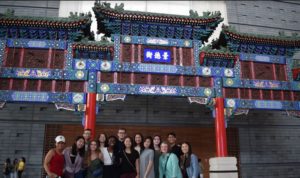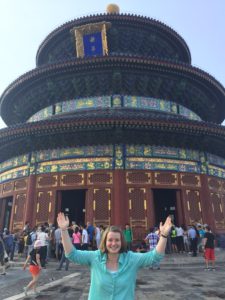My first week in Beijing was a whirlwind, to say the least! Between adapting to the challenging class load, figuring out how to order the food I wanted in the Peking University cafeterias (and figuring out what the food was in the first place!), and supplementing my still-developing Chinese language skills with a plethora of hand motions and head nods, I felt exhausted by the time the weekend rolled around. However, every Saturday the Notre Dame in Beijing program directors and professors plan an excursion for us – and I was not about to miss out on my first opportunity to explore this city!
China has an extraordinary, storied history that spans more than five thousand years. While people first settled in what is now Beijing nearly half a million years ago, it wasn’t until 1279 A.D. that it was first made China’s capital by Mongolian invaders. After turbulence in China and the eventual rise of the Ming Dynasty, Beijing became China’s permanent capital city in 1421 – it was at that time that the city’s grid system and many landmarks were created. Since then, the city has seen many major events – including the Boxer Rebellion, Mao Zedong’s revolution, and recently, an incredible modernization, population, and catapult to the world stage aided by the Beijing Olympics in 2008.
We got to learn more about some of this history by visiting the Beijing Capital Museum, 北京首都博物馆 (beijing shoudu bowuguan). The museum has extensive exhibits of porcelain ware, paintings, jade, bronze vessels, seals, needleworks, Buddhist statues, calligraphy, and coins from different times in China’s history – some pieces date as far back as the New Stone Age! My favorite part of the museum was the Exhibition on History. In the huge exhibit hall, the wall was lined with a timeline of major world events dating back hundreds of years (i.e. Hundred Years’ War, French Revolution, etc.), and the center of the hall across from the corresponding timeline dates were diagrams, pictures, and relics detailing life in China during that time. So, for example, I saw some traditional clothing and house wares, as well as read about what was happening in Chinese culture and economy, at the time when the American Revolutionary War was happening half a world away. It was a fantastic introduction to the history and beauty of China.

After leaving the museum, we took the subway to 天坛 (tiantan) – The Temple of Heaven. It is one of the few surviving ancient temples in the Beijing area, originally constructed in 1420 during the Ming dynasty and maintained very well ever since. The area consists not only of the iconic Hall of Prayer for Good Harvests and surrounding temples originally used for sacrifice and prayer, but also beautifully landscaped paths and gardens. The various temples, altars, and other architecture symbolize the relationship between heaven and the people on earth, and are masterpieces of ancient Chinese culture. It was fantastic to visit this beautiful, historic oasis in the middle of the huge, bustling city.



In addition to these trips, I learned a couple of other things this weekend – most notably, I had my first taste of 讨价还价 (taojiahuanjia) – bargaining at Chinese markets! I’m still a little put off by the aggressive shopkeepers and back-and-forth haggling process, but with a little more practice, I’ll be ready to get some of the cool and (very realistic) knock-off items offered at the various markets in Beijing! I also learned how to maneuver through Beijing’s extensive subway system – it is surprisingly clean, cool, and easy for an English speaker to navigate.
The Chinese have a saying that essentially means “When in Rome, do as the Romans do”: 入乡随俗 (ruxiangsuisu). This will be my motto as I continue to experience this new culture and make it my second home.
再见,朋友!